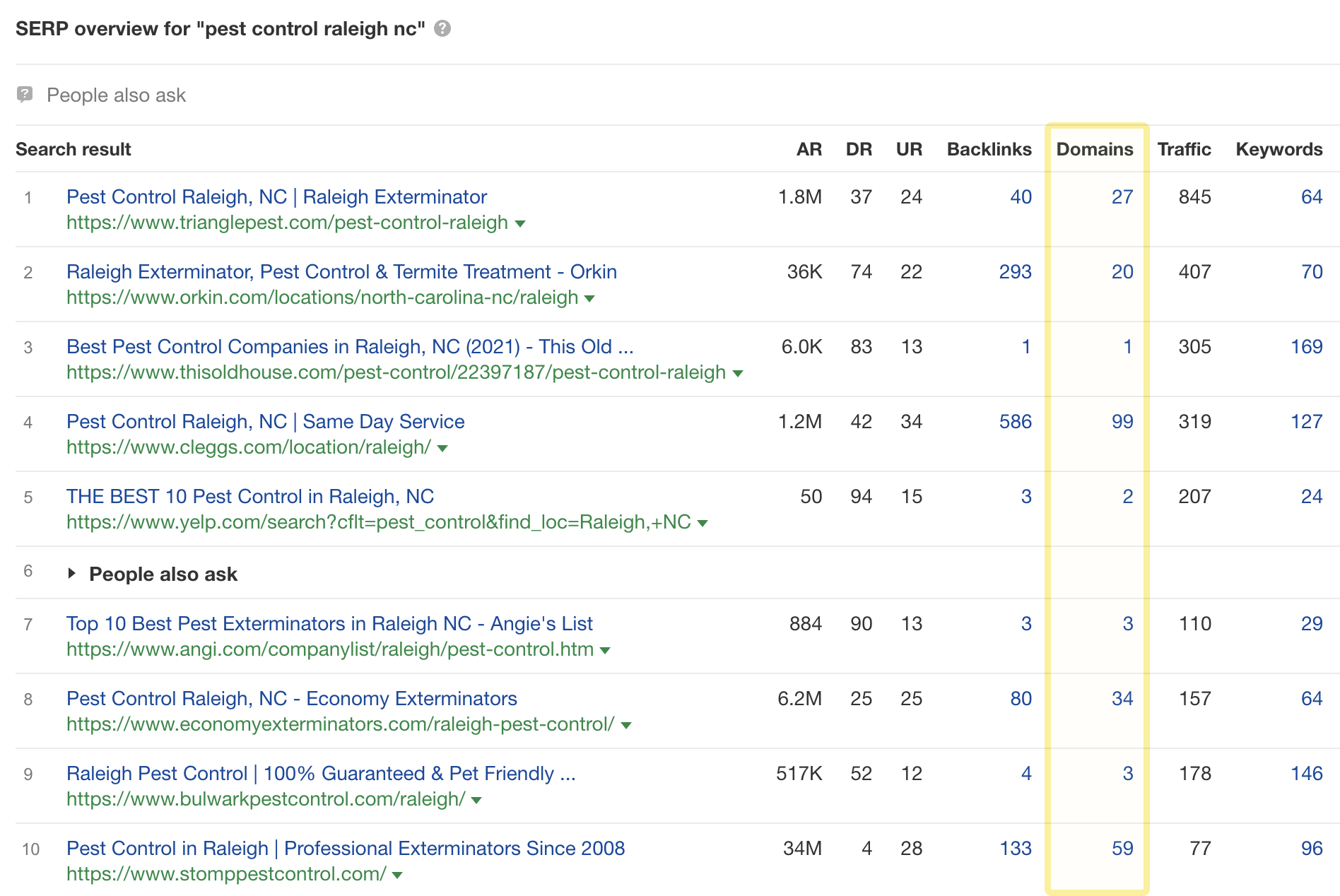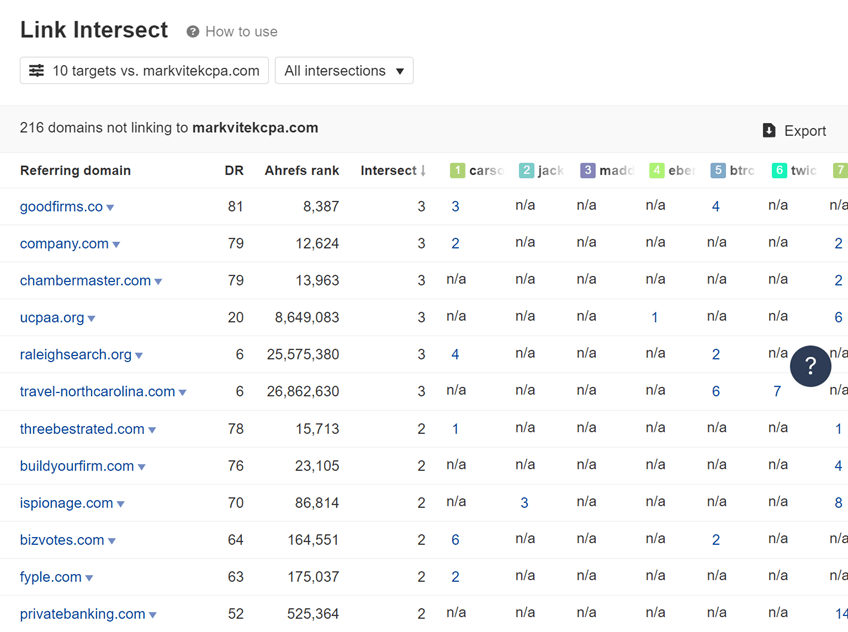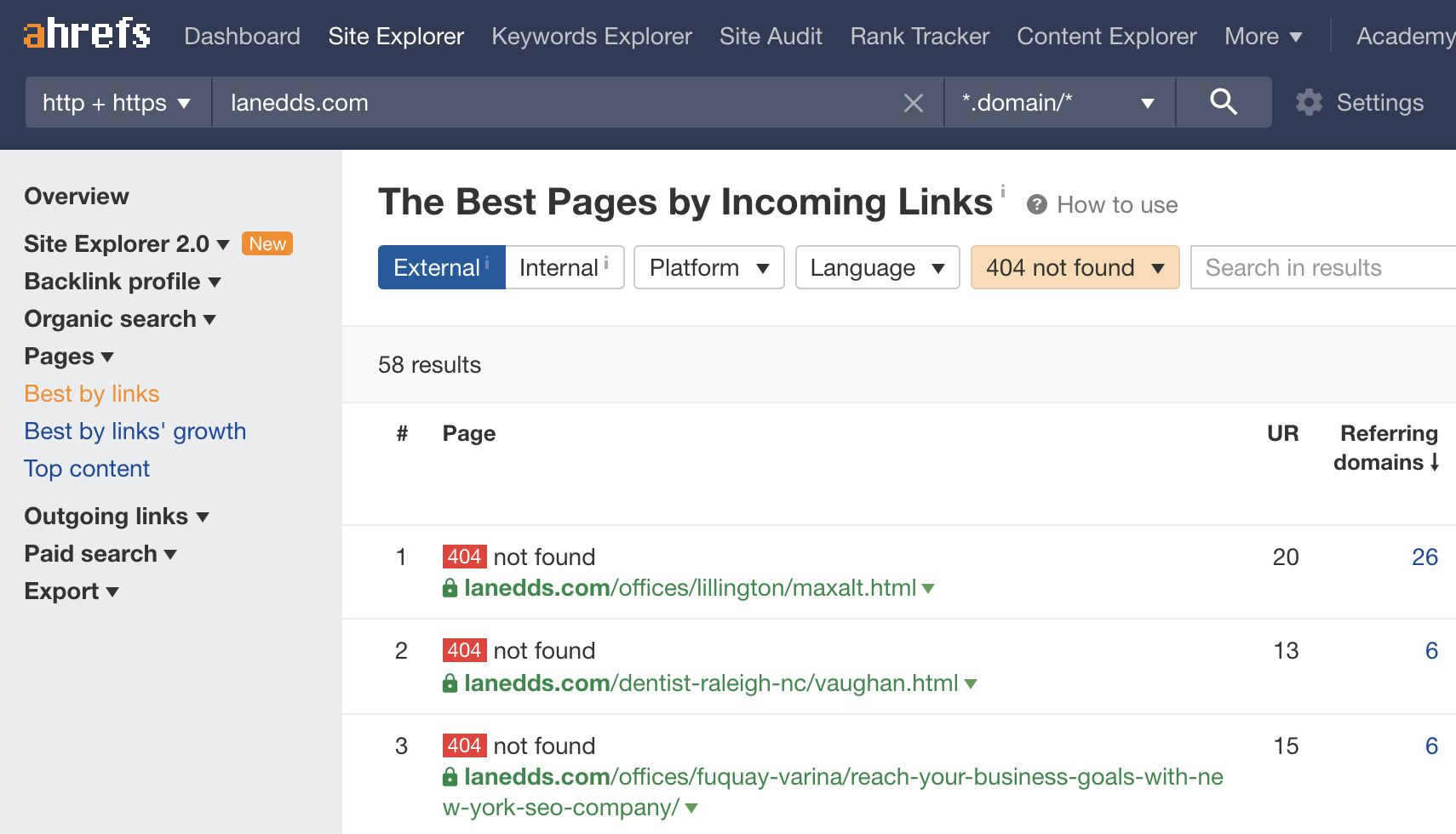I’ll show you nine ways to build local backlinks in this guide, but first, let’s cover the basics…
Local link building is the process of obtaining links to your website from websites in the same local market. The goal is to drive traffic and users to the website and help those sites rank better for local searches and in relevant map packs.
Most local businesses don’t need tons of links to rank in local search. Check the SERP overview for any local query in Keywords Explorer and you’ll rarely see businesses with more than 150 referring domains ranking on the first page:

You can use Keywords Explorer to get a sense of the competition for the keywords you’re targeting too. Just scroll to the SERP overview to see how many links the top-ranking pages have.
As with any link building, local link building requires research, hard work, perseverance, and creativity. Here are nine local link building tactics to get started:
- Get links from other ranking sites
- Get links your competitors have
- Reclaim lost links
- Create locally relevant content
- Get local citations
- Pursue other local link opportunities
- Claim unlinked mentions
- Buy companies, or at least their websites
- Add internal links
1. Get links from other ranking sites
This is a tactic sometimes referred to as Barnacle SEO. You simply search some of your relevant terms in Google and try to get links from sites that show up in the results.
You probably won’t get links from your competitors, but look for any aggregator or directory-type sites. When people are shopping for a company, they tend to use these types of sites. You can usually get listed on them just by signing up and adding your business. This is a quick and easy way to ensure you’re in the consideration set and get direct business value.

2. Get links your competitors have
If you look at the overlap of links to your competitors’ sites, there are probably a lot of contextually and locally relevant link opportunities. You can check this easily with Link Intersect. Simply add your site and your competitors into the tool and you’ll see which sites link to your competitors (but not to you).

What you’re likely to find are many links specific to your niche and a lot of directories. Many of these directories are referred to as local citations and include business data such as your name, address, and phone number.
3. Reclaim lost links
Websites change over the years, so you’ll often have links going to pages that no longer exist. By redirecting the old versions of your pages to the current versions, you recover those lost links and their value. Here’s how to do it:
- Paste your domain into Site Explorer
- Go to the Best by Links report
- Add a “404 not found” HTTP response filter
I usually sort this by “Referring Domains.”

4. Create locally relevant content
Content creation is the process of finding topics to attract your target audience, then planning, creating, and publishing content about those topics. For local content, think about content that’s relevant to your business and useful for your audience.
You may come up with topics like “what’s the best kind of grass for your area,” “what pests are most common,” or just the price of services in your area.
Granted, it’s pretty unlikely that this type of content will attract tons of links naturally. It tends to be easier to build links to with email outreach.
5. Get local citations
We already saw some of these opportunities when using Link Intersect. There are a lot of different citation services that exist, but besides sites that are ranking in your market, these are the ones you may want to start with for the US. Many of these feed their data to other websites and are generally considered the most important citations.
Main US aggregators:
- Data Axle
- Localeze
- Foursquare
Other major players:
- Google My Business
- Bing
- Apple Maps
- Yelp
- Yellowpages
- Dunn & Bradstreet
- TomTom
6. Pursue other local link opportunities
These are any links from other websites focused on your area. There are a lot of various opportunities if you look for them, and I’ll be doing a follow-up article with a process to find these.
For now, I’ll list a few opportunities:
- Colleges or Universities (e.g., job postings, scholarships, club sponsorships, discounts, alumni links)
- City-specific sites and directories
- Local news, magazines, and podcasts
- Some sites focus on the state or surrounding areas
- Local community groups (e.g., Reddit, Facebook groups, Nextdoor, etc.)
- Sponsorships in general (e.g., sports leagues, races, meetups, charities, etc.)
- Local awards
You can also leverage existing relationships. This may include things like testimonials or case studies for suppliers or affiliations. It could also be connections through churches, business groups, or even people. Ego bait works well at a local level if you want to do things like expert roundups.
7. Claim unlinked mentions
Unlinked brand mentions are where other sites talk about your company or people at your company but do not link back to your site. You will have the best luck with this tactic if you are in a niche that gets news coverage like lawyers or your company and/or people are already active in the community.
We have a complete guide on finding unlinked mentions to help you through this process.
8. Buy companies, or at least their websites
While this is more rare and situational, mergers and acquisitions do happen at the local level. Occasionally you can even find a company selling their already existing website or letting one of their domains lapse. By acquiring these, you have the option of having two ranking sites or one site that ranks better. These opportunities are pretty rare at a local level and I’ve only been able to do this a few times in my career but if you can manage to find an opportunity like this it’s extremely valuable.
9. Add internal links
Your site is also a local site and you control it. Internal links are a powerful link-building tactic. Check out our guide on finding these link opportunities.
Final thoughts
In my experience, people want to skip over these basic link-building tactics and go directly to more trendy or fun tactics, but that’s a lot riskier and rarely pays off. Do the basics, then go to the more creative and fun tactics as the company grows.
Got questions? Ping me on Twitter.




